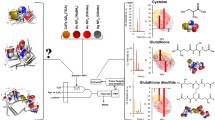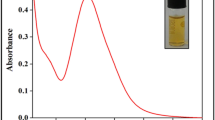Abstract
The abnormal changes of biothiols are directly related to health condition of human body, and the effective identification and quantification of biothiols is of great significance for screening and diagnosis of disease. This study described the development of a pH-regulated colorimetric sensor array for discrimination of five kinds of biothiols including cysteine (Cys), glutathione (GSH), homocysteine (Hcy), cysteamine (CA) and N-acetylcysteine (NAC). The proposed sensor array was established using 5-nm- and 20-nm-sized β-cyclodextrin-functionalized gold nanoparticles (β-CD@AuNPs) as nonspecific receptor and signal transduction elements. Due to the different binding affinity between biothiols and β-CD@AuNPs in various pH environments, the different aggregation behaviors of nanoparticles produced unique colorimetric response patterns, which were able to be distinguished by bare eyes and UV–vis spectrophotometer. Accordingly, principal component analysis (PCA) and hierarchical cluster analysis (HCA) were employed for pattern recognition and generated a clustering map for a clear differentiation of biothiols at the level of μmol/L. Furthermore, it can be proved that the method was successfully applied to the analysis of biothiols in human urine samples.





Similar content being viewed by others
Data availability
The data supporting the finding reported herein are available on reasonable request from the corresponding author.
References
Zhang Y, Li Y, Yan XP. Photoactivated CdTe/CdSe quantum dots as a near infrared fluorescent probe for detecting biothiols in biological fluids. Anal Chem. 2009;81:5001–7.
Li C, Wu C, Zheng J, Lai J, Zhang C, Zhao Y. LSPR sensing of molecular biothiols based on noncoupled gold nanorods. Langmuir. 2010;26:9130–5.
Shen TW, Ou TK, Lin BY, Chien YH. Plasmonic gold nanomaterials as photoacoustic signal resonant enhancers for cysteine detection. Nanomaterials. 2021;11(8):1887.
Mirac Dizman H, Kazancioglu EO, Shigemune T, Takahara S, Arsu N. High sensitivity colorimetric determination of L-cysteine using gold nanoparticles functionalized graphene oxide prepared by photochemical reduction method. Spectrochim Acta A Mol Biomol Spectrosc. 2022;264: 120294.
Deng H, Wu Z, Zhao Z, Zhu L, Tang M, Yu R, Wang J. Dual-channel fluorescent signal readout strategy for cysteine sensing. Talanta. 2021;231: 122331.
She ZP, Wang WX, Mao GJ, Jiang WL, Wang ZQ, Li Y, Li CY. A near-infrared fluorescent probe for accurately diagnosing cancer by sequential detection of cysteine and H+. Chem Commun. 2021;57:4811–4.
Wang Z, Zhu W, Xing Y, Jia J, Tang Y. B vitamins and prevention of cognitive decline and incident dementia: a systematic review and meta-analysis. Nutr Rev. 2022;80:931–49.
Chen S, Yang F, Xu T, Wang Y, Zhang K, Fu G, Zhang W. Appraising the causal association of plasma homocysteine levels with atrial fibrillation risk: A two-sample mendelian randomization study. Front Genet. 2021;12: 619536.
Han H, Wang F, Chen J, Li X, Fu G, Zhou J, Zhou D, Wu W, Chen H. Changes in biothiol levels are closely associated with Alzheimer’s disease. J Alzheimer’s Dis. 2021;82:527–40.
Wang H, Hua H, Tang H, Li Y. Dual-signaling amplification strategy for glutathione sensing by using single gold nanoelectrodes. Anal Chim Acta. 2021;1166: 338579.
Wang H, Liu Z, Xiao J, Li C, Wang J, Xiao X, Huang H, Shrestha B, Tang L, Deng K, Zhou H. Visual quantitative detection of glutathione and cholesterol in human blood based on the thiol–ene click reaction-triggered wettability change of the interface. Anal Chem. 2021;93:7292–9.
Jia P, Hou JJ, Yang KR, Wang L. On-off-on fluorescent sensor for glutathione based on bifunctional vanadium oxide quantum dots induced spontaneous formation of MnO2 nanosheets. Microchim Acta. 2021;188:299.
Bronowicka-Adamska P, Zagajewski J, Czubak J, Wróbel M. RP-HPLC method for quantitative determination of cystathionine, cysteine and glutathione: an application for the study of the metabolism of cysteine in human brain. J Chromatogr B. 2011;879:2005–9.
Espina JG, Montes-Bayón M, Blanco-González E, Sanz-Medel A. Determination of reduced homocysteine in human serum by elemental labelling and liquid chromatography with ICP-MS and ESI-MS detection. Anal Bioanal Chem. 2015;407:7899–906.
Carlucci F, Tabucchi A. Capillary electrophoresis in the evaluation of aminothiols in body fluids. J Chromatogr B. 2009;877:3347–57.
Munyemana JC, Chen J, Wei X, Ali MC, Han Y, Qiu H. Deep eutectic solvent-assisted facile synthesis of copper hydroxide nitrate nanosheets as recyclable enzyme-mimicking colorimetric sensor of biothiols. Anal Bioanal Chem. 2020;412:4629–38.
Xue G, Yu S, Qiang Z, Xiuying L, Tang L, Jiangrong L. Application of maleimide modified graphene quantum dots and porphyrin fluorescence resonance energy transfer in the design of “turn-on” fluorescence sensors for biothiols. Anal Chim Acta. 2020;1108:46–53.
Karimi A, Husain SW, Hosseini M, Azar PA, Ganjali MR. A sensitive signal-on electrochemiluminescence sensor based on a nanocomposite of polypyrrole-Gd2O3 for the determination of L-cysteine in biological fluids. Mikrochim Acta. 2020;187:398.
Fan YL, Lu YF, Ding XY, Wang NH, Xu F, Shi G, Zhang M. Fluorescent pattern recognition of metal ions by nanoparticles of bovine serum albumin as a chemical nose/tongue. Analyst. 2020;145:6222–6.
Fan J, Qi L, Han H, Ding L. Array-based discriminative optical biosensors for identifying multiple proteins in aqueous solution and biofluids. Front Chem. 2020;8: 572234.
Wang F, Na N, Ouyang J. A catalytic-regulated gold nanorods etching process as a receptor with multiple readouts for protein detection. Sens Actuators B. 2020;318(1):128215.
Yuan D, Liu JJ, Yan HH, Li CM, Huang CZ, Wang J. Label-free gold nanorods sensor array for colorimetric detection and discrimination of biothiols in human urine samples. Talanta. 2019;203:220–6.
He MQ, Chen S, Shi W, Zhang XW, Yu YL, Wang JH. All-in-one fractal nanoplasmonic array for visual discrimination of biomolecules and microorganisms. Sens Actuators B. 2021;338:129832.
Zhao Y, Huang Y, Zhu H, Zhu Q, Xia Y. Three-in-one: sensing, self-assembly, and cascade catalysis of cyclodextrin modified gold nanoparticles. J Am Chem Soc. 2016;138:16645–54.
Wen D, Liu W, Herrmann AK, Haubold D, Holzschuh M, Simon F, Eychmuller A. Simple and sensitive colorimetric detection of dopamine based on assembly of cyclodextrin-modified Au nanoparticles. Small. 2016;12:2439–42.
Liu YL, Male KB, Bouvrette P, Luong JHT. Control of the size and distribution of gold nanoparticles by unmodified cyclodextrins. Chem Mater. 2003;15:4172–80.
Ma Q, Fang X, Zhang J, Zhu L, Rao X, Lu Q, Sun Z, Yu H, Zhang Q. Discrimination of cysteamine from mercapto amino acids through isoelectric point-mediated surface ligand exchange of β-cyclodextrin-modified gold nanoparticles. J Mater Chem B. 2020;8:4039–45.
Zhang S, Zhou H, Kong N, Wang Z, Fu H, Zhang Y, Xiao Y, Yang W, Yan F. l-cysteine-modified chiral gold nanoparticles promote periodontal tissue regeneration. Bioact Mater. 2021;6:3288–99.
Basu S, Ghosh SK, Kundu S, Panigrahi S, Praharaj S, Pande S, Jana S, Pal T. Biomolecule induced nanoparticle aggregation: effect of particle size on interparticle coupling. J Colloid Interface Sci. 2007;313:724–34.
Zhang FX, Han L, Israel LB, Daras JG, Maye MM, Ly NK, Zhong CJ. Colorimetric detection of thiol-containing amino acids using gold nanoparticles. Analyst. 2002;127:462–5.
Han Y, Chen Y, Feng J, Liu J, Ma S, Chen X. One-pot synthesis of fluorescent silicon nanoparticles for sensitive and selective determination of 2,4,6-trinitrophenol in aqueous solution. Anal Chem. 2017;89:3001–8.
Liu L, Zhu G, Zeng W, Yi Y, Lv B, Qian J, Zhang D. Silicon quantum dot-coated onto gold nanoparticles as an optical probe for colorimetric and fluorometric determination of cysteine. Mikrochim Acta. 2019;186:98.
Li P, Lee SM, Kim HY, Kim S, Park S, Park KS, Park HG. Colorimetric detection of individual biothiols by tailor made reactions with silver nanoprisms. Sci Rep. 2021;11:3937.
Botteon CEA, Silva LB, Ccana-Ccapatinta GV, Silva TS, Ambrosio SR, Veneziani RCS, Bastos JK, Marcato PD. Biosynthesis and characterization of gold nanoparticles using Brazilian red propolis and evaluation of its antimicrobial and anticancer activities. Sci Rep. 2021;11:1974.
Acknowledgements
The authors thank the financial support from the National Natural Science Foundation of China (82073603); Jilin Province Science and Technology Development Plan Item (20200602010ZP); Health Commission of Jilin Province (2020Q011) and Norman Bethune Health Science Center of Jilin University (2020B39).
Author information
Authors and Affiliations
Corresponding authors
Ethics declarations
Competing Interests
The authors have no competing interests to declare that are relevant to the content of this article.
Supplementary Information
Below is the link to the electronic supplementary material.
About this article
Cite this article
Li, H., Zhao, C., Wei, S. et al. A pH-Regulated Colorimetric Sensor Array for Discrimination of Biothiols Based on Two Different-Sized β-Cyclodextrin-Functionalized AuNPs. J. Anal. Test. 7, 101–109 (2023). https://doi.org/10.1007/s41664-023-00249-z
Received:
Accepted:
Published:
Issue Date:
DOI: https://doi.org/10.1007/s41664-023-00249-z




